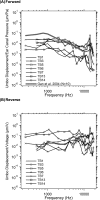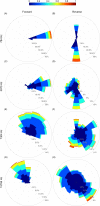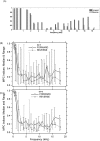Tympanic membrane surface motions in forward and reverse middle ear transmissions
- PMID: 30710932
- PMCID: PMC6338545
- DOI: 10.1121/1.5087134
Tympanic membrane surface motions in forward and reverse middle ear transmissions
Abstract
Characterization of Tympanic Membrane (TM) surface motions with forward and reverse stimulation is important to understanding how the TM transduces acoustical and mechanical energy in both directions. In this paper, stroboscopic opto-electronic holography is used to quantify motions of the entire TM surface induced by forward sound and reverse mechanical stimulation in human cadaveric ears from 0.25 to 18.4 kHz. The forward sound stimulus was coupled to an anatomically realistic artificial ear canal that allowed optical access to the entire TM surface, and the reverse mechanical stimulus was applied to the body of the incus by a piezo-electric stimulator. The results show clear differences in TM surface motions evoked by the two stimuli. In the forward case, TM motion is dominated by standing-wave-like modal motions that are consistent with a relatively uniform sound-pressure load over the entire TM surface. With reverse mechanical stimulation, the TM surface shows more traveling waves, consistent with a localized mechanical drive applied to the manubrium embedded in the TM. With both stimuli, the manubrium moves less than the rest of the TM, consistent with the TM acting like a compliant membrane rather than a stiff diaphragm, and also consistent with catenary behavior due to the TM's curved shape.
Figures











References
-
- Cheng, J. T. , Aarnisalo, A. A. , Harrington, E. , Hernandez-Montes M. S., Furlong, C. , Merchant, S. N. , and Rosowski, J. J. (2010). “ Motion of the surface of the human tympanic membrane measured with stroboscopic holography,” Hear. Res. 263, 66–77.10.1016/j.heares.2009.12.024 - DOI - PMC - PubMed
-
- Curtis, J. (2007). “ Wind Rose data,” Natural Resources Conservation Service, https://www.wcc.nrcs.usda.gov/climate/windrose.html (Last viewed January 9, 2019).
Publication types
MeSH terms
Grants and funding
LinkOut - more resources
Full Text Sources

